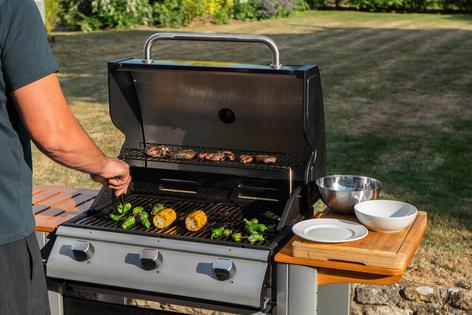Environmental Nutrition: Fire it up
Published in Health & Fitness
The late Anthony Bourdain once quipped: “Barbecue may not be the road to world peace, but it’s a start.” Indeed, cooking over flame is a joyful activity that makes food more exciting to eat, even if it can’t end wars. But along with those enticing smells and tastes can come some health risks if you’re not careful. With grilling season upon us, it’s time to brush up on food safety basics. Here’s how to enjoy the thrill of the grill without burning your health.
Incinerate harmful bugs
Bacteria like E. coli in meat easily flourish in warmer temperatures. You don’t want to rely on imprecise methods like cutting into meats to determine if they are safe to eat. Instead, registered dietitian nutritionist, chef, and author of “The Low-Carb Mediterranean Cookbook,” Michelle Dudash, recommends using a digital instant-read thermometer to ensure you’ve cooked meats to the temperature needed to kill harmful bacteria.
“Make sure the thermometer probe is not touching bone, which can give an erroneous reading, and the notch on the probe is fully inserted into the thickest part of the meat,” says Dudash. Grill cuts of red meat like steak and pork chops to an internal temperature of at least 145 F, followed by a three-minute rest time. Poultry should be prepared to 165 F, fish to 145 F, while all types of ground meat (including beef and chicken) need to be heated to 160 F.
Handle with care
Pay attention to how you are handling meats during and after the grilling process to limit food poisoning risk. Once cooking utensils like tongs come in contact with meat that is not fully cooked, you should consider them contaminated. Make it a habit to use clean utensils and plates to remove cooked meat from the grill.
Eat up
You shouldn’t let cooked meats sit around too long after taking them off the grill. “The danger zone for meat and other potentially hazardous foods is between 40 and 140 F (so holding food at 41 to 139 F) and food should not be in this range for more than two hours, since harmful bacteria can replicate quickly in this temperature zone,” says Dudash. When in the “danger zone,” bacteria can double in as little as 20 minutes, per the USDA. Dudash explains that grilled meats should either be eaten soon after cooking, held hot above 140 degrees, or properly refrigerated for consumption later.
Banish the char
When meats are seared at high temperatures, such as grilling, it creates compounds called advanced glycation end products — or AGEs — which, when consumed, can accumulate in your body and possibly raise the risk for certain cancers and other health conditions. Two such troubling AGE compounds are heterocyclic amines and polycyclic aromatic hydrocarbons. “Reducing charring on meats by grilling them at a lower temperature can limit the formation of these harmful compounds,” Dudash says. Avoiding direct contact between flame and food and flipping meat more often during grilling will also lessen the risk for charring and AGE production. “If you do char your meat, slice it off before eating,” advises Dudash.
...continued







Comments